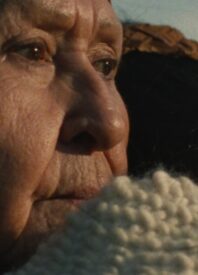
Guess what – more shorts! ImagineNATIVE calls its tenth program Long Line of Ladies, which shows an Indigenous take on girlhood and womanhood. This program reaches out to Indigenous proper worldwide, as usual. These shorts depict transformation, whether it’s girls growing up to become women, or women accessing new worlds, not letting settler oppression stop them. On a personal note, this is *the* program of the ones I saw so far. These shorts have their premiere during my birthday, so seeing them feels like getting a birthday present early.
Members of the Karuk tribe create objects for an Ihuk ceremony in Long Line of Ladies. The Karuk tribe also call the Ihuk ceremony also call the Flower Dance. It is a month long ritual that girls participate in once they get their first period. The sound design catches the girls’ conservations so well. One of them says “I’m doing this fasting and blindfolded, I got this”. Hearing this confidence makes this a favourite. Being this first short I’m seeing in this program, the other shorts are gonna need to top this. Forrest Goodluck’s compositions also work well here.
In Evelyn Lorena’s Gabriela, where the titular Kaqchikel girl (Lorena) is alone, sitting at the edge of the pool. Living in South Carolina, she has to quit the swim team in her school. And the only place where she can practice is at a country club where she has to sneak in. She wears lighter makeup. But even then, the white members still can see her Amerindian features and says things that she can hear within earshot. Lorena is also responsible for writing this short. But her best work is in directing, adding double meanings through her images.
Next up is Mother (EADNI), showing a Sami girl’s hand reaching out to the earth, feeling her mother’s warmth within it. One day, her mother walks into the woods. She tries to follow her mother but the mother becomes a trickster figure within. This short gives the flora its unique life. The effects here remind me of that what these girls from a hundred years ago did to convince Shir Arthur Conan Doyle that faeries existed. But that gives this short a collage-y effect that complements its ethos.
A woman, Kayah George narrates her emotions in her and Jaime Leigh Gianopoulos’ film Our Grandmother the Inlet, as she expressing her sinking feeling, a defenselessness in fighting against a pipeline that’s destroying the bodies of water surrounding her Tsleil-Waututh nation. This short uses familiar visual language to express that defenselessness as well as her people’s resilience. There’s a tendency here for the narration to seem Malick-y, but thankfully, George speaks with such deliberate speed, making her words her own.
In Kaayla Whachell’s Nisihkason Lex, her titular subject is an Indigenous woman, Alexa, living in Lloydminster, Alberta, bordering Saskatchewan. It’s a small city with three times more Indigenous people than the Canadian average, but the majority still assumes they want to assimilate. In capturing this struggle, Alexa shares the spotlight with her family, friends, and school staff who helped her graduate high shcool and start Digital Voices, a no judgment platform where girls like her can share their experiences with abuse. This is a beautofil love letter to a community and admittedly, it made me tear up a bit. I watched these shorts out of order again and this one’s a great way to end the program.
- Genre: Animation, Documentary, Drama
- Release Date: 10/22/2023
- Directed by: Documentary, Evelyn Lorena, Jaime Leigh (Demetra) Gianopoulos, Kaayla Whachell, Kathleen Mantel, Kayah George, Liselotte Wajstedt, Rayka Zehtabchi, Sam Davis, Shaandiin Tome
- Starring: Evelyn Lorena
- Produced by: Sam Davis
- Written by: Evelyn Lorena

